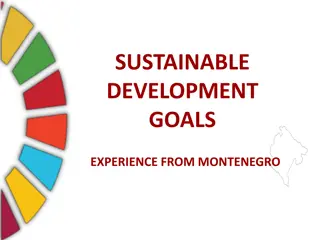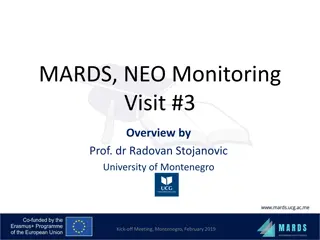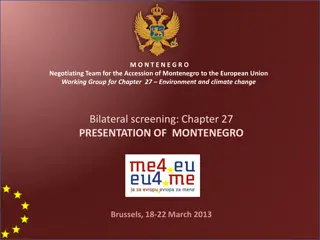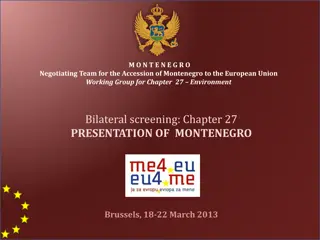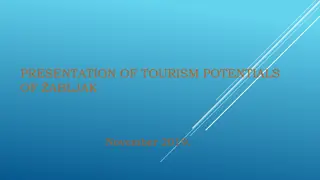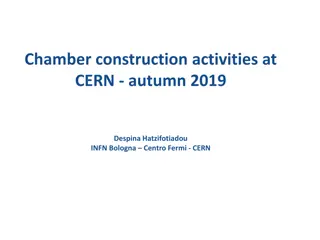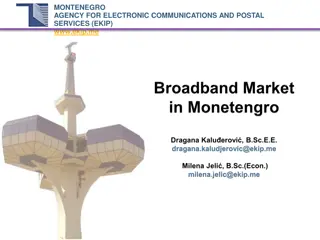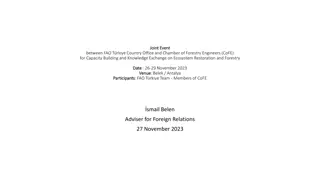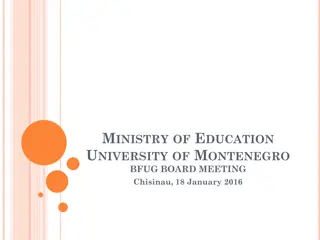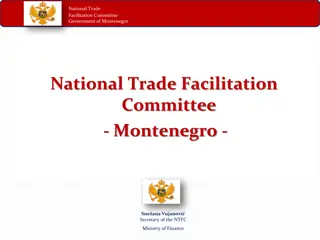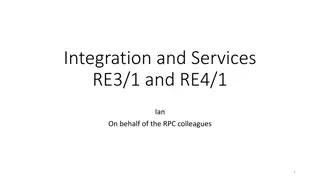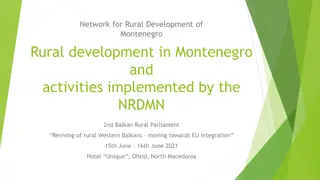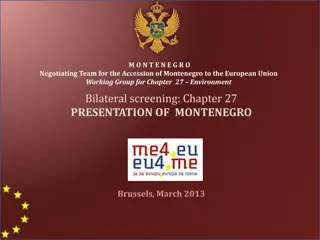
Discover Montenegro: Population, Resources, and Development Insights
"Explore Montenegro's population, natural resources, geographic areas, European integration efforts, development priorities, macroeconomic indicators, industry growth, and trade exchange. Learn about its tourism, agriculture, energy sector, and more."
Download Presentation

Please find below an Image/Link to download the presentation.
The content on the website is provided AS IS for your information and personal use only. It may not be sold, licensed, or shared on other websites without obtaining consent from the author. If you encounter any issues during the download, it is possible that the publisher has removed the file from their server.
You are allowed to download the files provided on this website for personal or commercial use, subject to the condition that they are used lawfully. All files are the property of their respective owners.
The content on the website is provided AS IS for your information and personal use only. It may not be sold, licensed, or shared on other websites without obtaining consent from the author.
E N D
Presentation Transcript
MONTENEGRO Population 620 029 (census 2011) Surface 13 812 km2 Border length 614 km (coast length 293 km) Administrative Capital Podgorica (185 937 inhabitants)
NATURAL RESOURCES agricultural area of 0.32 ha per capita 1 ha of forest per capita 40 natural lakes 4 dams great river potentials mineral wealth NATIONAL PARKS Durmitor Lov en Biogradska gora Skadarsko jezero Prokletije
GEOGRAPHIC AREAS Northern mountanious Tourism, animal husbandry, agriculture, forests, hydro potential Central The biggest plain in Montenegro and the most fertile area Southern coastal Beautiful coast, sandy beaches (tourism, maritime economy, fishery, salt production)
EUROPEAN AND ATLANTIC INTEGRATION OF MONTENEGRO CEFTA 2006 signed 19th of December 2006. The Stabilization and Association Agreement signed 15th of October 2007. Interim SAA effective from 01.01.2008. Submited answers to a questionnaire 09.12.2009. Candidate status for EU membership 17.12.2010. Member of the WTO 29 April 2012. Negotiations for EU membership began in June 2012.
DEVELOPMENT PRIORITIES OF MONTENEGRO Tourism Agriculture Energy Sector
MACROECONOMIC INDICATORS Year 2006 2007 2008 2009 2010 2011 2012 Inflation (%) 2,00 7,70 6,90 1,50 0,70 2,80 5,10 Rate of 14,60 11,90 10,70 11,43 12,13 11,50 13,50 Unemployment (%) Foreign debt (mil ) 504,00 462,10 481,70 699,90 912,40 1.063,7 - Foreign debt as % of GDP 23,40 17,20 15,60 23,50 29,40 32,50 - Current Account Balance (mil ) -673,50-1,058,7 -1,535,2 -830,30 -710,20 -573,40 -587,60 Deficit/surplus of budget (mil ) 85,10 173,00 15,10 -132,10 -112,30 -189,70 -163,80 % of participation GDP 3,90 6,40 0,50 -4,40 -3,60 -5,90 -4,90
INDUSTRY GROWTH RATE 17.5 13.8 3.7 2.4 1 0.1 0.6 -2 -1.9 -0.7 2001 2000 2002 2003 2004 2005 2006 2007 2008 2009 2010 2011 2012 -10.3-7.1 TRADE EXCHANGE -32.2 1617.90 1428.20 2027.80 2475.70 1623.80 1782.80 1781.10 1011.20 868.60 629.90 483.40 476.50 462.00 452.10 450.40 391.90 369.30 356.60 296.30 270.60 2003 2004 2005 2006 2007 2008 2009 2010 2011 2012 -359.30 -416.40 -641.90 -966.20 -1544.40 -2025.30 -1321.60 -1267.20 -1306.20 -1389.20 Export ImportTrade deficit
MONTENEGRO AS THE WORLD CAN SEE IT World Bank Doing Business Bilateral Relations Year Rank Montenegro has signed: 15 agreements on economic cooperation 10 agreements on the reciprocal promotion and protection of investments Free trade agreements with EU, CEFTA, EFTA, Russia, Turkey, Ukraine while negotiations with Belarus and Kazakhstan are still in progress 2008 81/178 2009 2010 2011 90/181 71/183 66/183 2012 56/183 World Economic Forum Global Competitiveness Report (1-7) Year Rank 4,11 2008-2009 65/134 4,16 4,36 4,27 2009-2010 2010-2011 2011-2012 62/133 49/139 60/142 4,14 2012-2013 72/144
ORIGIN OF INVESTORS Investors are coming from 88 countries There is no domination of any country relative to the number of registered investors
FOREIGN INVESTORS IN MONTENEGRO Other 28% Germany 3% Slovenia 4% Serbia 5% Russia 12% Cyprus 7% United Kingdom 7% Italy 10% Austria 8% Hungary 8% Switzerland 8%
IMPORTANCE OF FOREIGN DIRECT INVESTMENTS 1,224 Speeding up the reform processes; Changing the structure of the economy; Contributing to GDP, GDP growth, employment, budget revenues, export/import Developing regional cooperation FDI s are changing way of thinking 1057.2 847.3 652.8 647.3 494.7633.3 410.8 2005 2006 2007 2008 2009 2010 2011 2012 2006 33% 25% 10% 10% 8% 4% 2% 8% 505 2007 30% 23% 12% 12% 9% 5% 2% 7% 678 2008 28% 22% 14% 10% 11% 5% 2% 8% 685 2010 24% 21% 9% 22% 9% 5% 2% 8% 692 2011 21% 24% 8% 23% 10 4% 2% 8% 534 FDI per sectors Finance Tourism Construction Industry Services Transport Agriculture Other Total 2009 11% 14% 8% 48% 6% 4% 2% 7% 1,070
investors from 88 countries State FDI inflow in % Of total FDI 1 Italy 486 .804 .302 11.8 2 Russia 478 .002. 577 11.6 3 Hungary 355 .691 .493 8.6 4 Great Britain 322 .229. 047 7.8 5 Cyprus 309 .760 .754 7.5 6 Switzerland 305 .170. 662 7.4 7 Austria 298 .424 .903 7.2 8 Serbia 159 .497. 818 3.9 9 Germany 145 .354 .720 3.5 10 Slovenia 683 .267 3.5 source: MIPA
standard rate 19 % lower rate 7 % VAT corporate profit tax flat rate 9 % personal income tax flat rate 15 % proportional tax ranging between 0.1 % - 1% of the immovable property s market value property tax Exemption from the income tax payment a newly-established legal entity in economically underdeveloped municipalities which performs production activity is exempted from paying income tax for the first eight years following the beginning of business operations, on the income generated by performing the business activity in the underdeveloped municipality a tax payer who makes a profit in a newly established business unit which performs production activity in underdeveloped municipalities is reduced the income tax for eight years proportionate to the share of the profit thus generated in the total profit of the tax payer.
REASONS TO INVEST IN MONTENEGRO? Politicaly, monetary and macroeconomic stability Simple START UP (1 euro + 4 days) National treatement same rights and obligations as domestic Free money transfer The same taxation for everyone Liberal economic regime of foreign trade Favorable tax policy 9% profit tax, 7/19% VAT, 9% income tax International accounting standards Growth of economic freedoms Geographical location and climatic conditions




